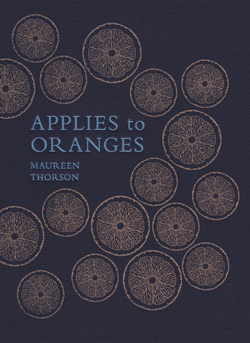

Reviewed March 9, 2012 by Sara Renee Marshall.
After reading Maureen Thorson’s Applies to Oranges, I’m thinking instinctively of the serious little boy on a ship in J.D. Salinger’s story “Teddy” who—while listening to his parents argue—watches orange peels bob along the wake from a porthole. The peels eventually disappear from view; Teddy, philosophizing, recognizes he’s left to the fuzzy film reel of his mind’s eye, where the image itself started. Thorson’s poems—and her oranges—have a related cause and effect: her ever-changing frames try to handle, distract from, or worry ideas, which are most often failed communication and loss.
It seems Thorson picked the perfect primary object—the word “orange”—to take up residence on every page. Orange, the awkward word that can’t be rhymed. Orange, so vastly other than the iconic apple. Orange, an inassimilable color, a shocking sunset, an obnoxious cocktail, a flame, a pulpy mess, a sore thumb—as unforgettable and irrevocable as the nasty condemnation you blurted at a loved one.
In a surprising combination of devices, these poems recall Mary Ruefle and James Tate. How, exactly? In their agile shifts between visual detail and abstraction, figured—by a deeply interior voice—into cinematic scenes. Thorson’s untitled serial poems masquerade as narratives, one to a page. Each poem seems to begin again, offering its constellation of words as if they were brand new, washed of their previous contexts and associations. With new language and props on each page, she integrates recycled and reworked language from a finite vocabulary: spiders, smoke, shards, orphans, the Zenith, shadows, an island, a screen, sugar, ships, rivers, and—foremost among these—oranges. Much orbits around and interacts with this system of nouns, changing them, inverting them, re-contextualizing them, or manipulating their use as adjectives, verbs, or otherwise. Take two examples for comparison:
AND
Some faint similarity lingers in their effects—echoes of specters and fiery light, and the encounter of an “alley thick with discarded flowers” in the first feels like an associative cousin to sealed memories in the next.
Both excerpts above demonstrate Thorson’s potent, paratactic lines and enjambments. In the second stanza, Thorson’s speaker asks that we “imagine the island,” then surprises with her next line, “ablaze from end to end,” followed by “the ghosts,” enabling a dual reading: the island is enflamed, or the island is enflamed with ghosts. Her propulsion gains momentum and intensity as the stanza proceeds: “…the sugar sand / caramelized. Moonsnail lacquer, / baked with footprints,” where heated sand liquefies, like imaginary slime from a moon snail. Or as in “to seal these memories: five thousand / degrees, ten stories high. A pillar / of fire…” where her poetic line suggests memories are either numbered, “five thousand,” to show the speaker’s emotional inundation, or the memories are vitrified, like footprints baked into sand by a five thousand degree pillar of fire. Thorson puts her units of language to work. These poems construct an intuitive labyrinth, alluring in its freshness, and always rich in emotional complexity. In these narratives—part movie set, part emotional encounter, part imaginary manifestation—Thorson found a balanced, yet dynamic vehicle.
Speaking of imagination, it’s important to bookmark here the privilege Thorson gives to imaginary pathways in her work—an inheritance, perhaps, from American Surrealism. This freedom permits and smoothes Thorson’s associative leaps, as in:
Combined with her recycled vocabulary, the effect is that of a sensory déjà vu in a dream state. Perhaps you don’t remember a pier over there, or those children, or trees turning orange when filled up with birds. And Thorson’s chosen word set seems to liberate rather than limit her; under the constraint of repetition, she reinvents the behavior, impression, and setting of her language on every page.
If these poems are purposefully inchoate or abandoned narratives, this method, it turns out, is the perfect expression for Thorson’s emotional poignancy. This book coheres in its continual address of loss, mourning, and regret. Consider this passage:
Her varied line lengths here build a rhythm and somehow a performative gusto—a means of expression for her sarcasm. Thorson’s speaker describes the failure of objects (even language) as metaphors for love, let alone as healing treatments. A diamond fails to express marriage or commitment—the ultimate miscommunication and a great instance of Thorson’s clever irony in a series of poems relying on paltry, familiar objects to articulate themselves. It’s because of the speaker’s complicity in failed gestures—and frankly, self-effacement—that these poems endear.
What Thorson ultimately describes are those pathologies that infiltrate and slowly corrode intimacy. She describes despondence, distance, and communicative misfires, regret like a live virus that infects a union. In this, Thorson manages to be both crestfallen and silly, profound and devastating: “I’d rather tell you a better story, but / disease and boredom and a bad connection / brought that plan to night.”
***
Sara Renee Marshall lives and writes in Denver.